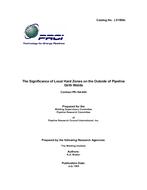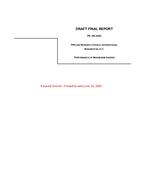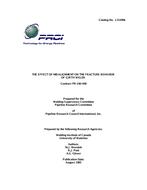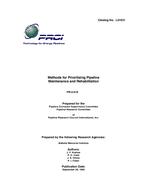Provide PDF Format
PRCI PR-164-804
- The Significance of Local Hard Zones on Outside of Girth Welds
- Report / Survey by Pipeline Research Council International, 07/01/1989
- Publisher: PRCI
$98.00$195.00
L51599e
The Welding Institute (UK)
Need: In petrochemical and oil and gas production plant the presence of sour H2S containing environments poses problems with regard to material behavior. The corrosion reaction between H2S and steel produces atomic hydrogen, which enters the steel and may, for example, lead to hydrogen pressure cracking (HPC) if steel quality is such that inclusion levels promote the entrapment of hydrogen gas. Fortunately this problem may be readily controlled by attention to steel cleanliness. A potentially more serious problem relating to sour environments is sulphide stress cracking (SSC), when the presence of hydrogen may lead to stress corrosion cracking in a susceptible material. In carbon-manganese steels, susceptibility to SSC is associated with a hardened microstructure and control of the problem therefore requires limitations on material hardness. This is especially important in welded structures where the rapid cooling associated with welding may lead to a hardened heat affected zone (HAZ), together with significant residual welding stress.
Result: To determine to what extent a relaxation in external hardness could be possible, The Welding Institute proposed a program of work to study the influence of hardness and stress levels on the cracking propensity of GMA welds in pipeline steel. The project was to be carried out in two phases: in the first, the hardness limit for internal GMA bead on pipe welds (simulating weld root regions) was to be determined in a sour (NACE) solution; in Phase 2, external bead on pipe welds (simulating weld cap regions) would be assessed, again with the sour environment on the inside of the pipe. This report presents the results of both phases of the study. In order to study the influence of wall thickness on cracking behavior, seamless pipe materials to API-5L-X52 specification were obtained in 408 mm (16 in) diameter with nominal wall thickness of 9.5, 12.7, 19.0 and 25.4 mm (0.37, 0.5, 0.75 and 1.0 in). Chemical analysis results are given. The materials were supplied in accordance with NACE MR-01-75 hardness specifications (22 HRC max), although no additional requirements were specified. Pipe B, which was obtained from a different supplier to the remaining pipes, had significantly higher sulfur content. Some variations existed between parent material microstructures, although all may be considered typical of the grade of steel.
Benefit: This program seeks to determine the threshold hardness level for sour service of as-deposited (un re-heated) weldment regions in the capping pass of girth welds in pipeline steel. Assessment has been made by comparing the cracking behavior in the NACE TM-01-77 test environment of internal and external single pass welds produced with a range of conditions by the GMAW process.
The Welding Institute (UK)
Need: In petrochemical and oil and gas production plant the presence of sour H2S containing environments poses problems with regard to material behavior. The corrosion reaction between H2S and steel produces atomic hydrogen, which enters the steel and may, for example, lead to hydrogen pressure cracking (HPC) if steel quality is such that inclusion levels promote the entrapment of hydrogen gas. Fortunately this problem may be readily controlled by attention to steel cleanliness. A potentially more serious problem relating to sour environments is sulphide stress cracking (SSC), when the presence of hydrogen may lead to stress corrosion cracking in a susceptible material. In carbon-manganese steels, susceptibility to SSC is associated with a hardened microstructure and control of the problem therefore requires limitations on material hardness. This is especially important in welded structures where the rapid cooling associated with welding may lead to a hardened heat affected zone (HAZ), together with significant residual welding stress.
Result: To determine to what extent a relaxation in external hardness could be possible, The Welding Institute proposed a program of work to study the influence of hardness and stress levels on the cracking propensity of GMA welds in pipeline steel. The project was to be carried out in two phases: in the first, the hardness limit for internal GMA bead on pipe welds (simulating weld root regions) was to be determined in a sour (NACE) solution; in Phase 2, external bead on pipe welds (simulating weld cap regions) would be assessed, again with the sour environment on the inside of the pipe. This report presents the results of both phases of the study. In order to study the influence of wall thickness on cracking behavior, seamless pipe materials to API-5L-X52 specification were obtained in 408 mm (16 in) diameter with nominal wall thickness of 9.5, 12.7, 19.0 and 25.4 mm (0.37, 0.5, 0.75 and 1.0 in). Chemical analysis results are given. The materials were supplied in accordance with NACE MR-01-75 hardness specifications (22 HRC max), although no additional requirements were specified. Pipe B, which was obtained from a different supplier to the remaining pipes, had significantly higher sulfur content. Some variations existed between parent material microstructures, although all may be considered typical of the grade of steel.
Benefit: This program seeks to determine the threshold hardness level for sour service of as-deposited (un re-heated) weldment regions in the capping pass of girth welds in pipeline steel. Assessment has been made by comparing the cracking behavior in the NACE TM-01-77 test environment of internal and external single pass welds produced with a range of conditions by the GMAW process.
Related Products
PRCI PR-186-0025
Development of Quality and Performance Specifications For Magnesium Anodes..
$148.00 $295.00
PRCI PR-273-0135
Gas Decompression Behavior Following the Rupture of High Pressure Pipelines - Phase 1..
$6.00 $12.00





